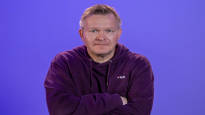Squash should have made it to the Olympic Games when there were 600 courts in Finland. The legend of the sport sees padel’s economic crisis as a lot of points of contact with the downfall of his own sport, writes Pekka Holopainen.
Pekka Holopainen sports reporter
A snapshot of west London’s Fulham from the beginning of the 21st century. No matter what day or time of the day it was, the radio of the newsstand run by an Indian guy was always on the Indian frequency and there was one and the same thing coming out of it: cricket. It was either played or speculated. I didn’t even know how to read a match report in a newspaper, and to be honest, I didn’t have much motivation to learn.
When the game, passionately followed by a billion people, returns to Los Angeles in 2028 as an Olympic sport after a 128-year hiatus, it is more than appropriate that the International Olympic Committee blessed it at its board meeting in Mumbai, India.
Most interesting to Finns a new sport however, we are not very unfamiliar with cricket, but with the sweaty hit sport of the 1980s, squash. It has made a good attempt to become an Olympic sport a couple of times before, but hit the tin in the decision place, so to speak.
Of course, it’s great for the sport that it will make it to the 2028 Los Angeles Games, but squash with its waiting times would have already been part of the previous Los Angeles Games – in 1984.
The sport has fulfilled the Olympic requirements for decades: global number of enthusiasts and distribution, vibrant professional tour, anti-doping activities, affordable sports infrastructure, easy and compact TV implementation and so on.
Too late for Finland
If squash had received its Olympic place more than 30 years ago, the tournament would have been eagerly awaited in Finland. Sami Elopuro The 6th place in the rock-hard world ranking at the time, the 1991 World Championship team bronze and almost 10 European Championship team medals are great achievements in Finnish racket game history. The middle of these is challenged by the fresh quarter-final spot of the tennis Davis Cup. No Finnish racket player has appeared higher than Elopuro in the world rankings.
In the eyes of the modern generation, these Elopuro Pentti Pekkanen and Marko Pullin sea ice is covered in a thick dust of oblivion, and cupball has largely lost its game as a competitive sport and hobby. In Finland, there are only about 500 licensed athletes who compete in twenty thousand regular or occasional sports. Due to the loss of enthusiasts, huge amounts of fields in sports centers have been used for other, more commercially profitable uses.
In Egypt, the current number one country in squash, a single junior tournament might have 4,000 youngsters playing.
In particular, the news about squash’s Olympic silver bullet upsets those who lived through the most physically active phase of the 1980s and early 1990s.
In the core center of Helsinki alone, you could find a dozen field centers tuned to the most different and vague spaces. According to the best information, a total of 600 fields were made in Finland. The rubber ball was heated and sweatbands were wringed dry across the length and breadth of the country. Squash is the nobility of forms of exercise.
100,000 players
At its peak, up to 100,000 different Finns played the sport every week. When Elopuro needed a training club, it was always found in Helsinki, at least ten players who were serious about their careers. Today, the best Finnish man is ranked 167th in the world.
The Finnish racquet game phenomenon of the 2020s has been unmatched by padel, which grew in its time as explosively as squash in the 1980s. The recently accelerated news about the plight of padel athletes shows that history mercilessly repeats itself, also in the sports business.
When Finland was still living the last illusion of a boom in 1991 before a long and dark depression, the squash World Cup team bronze wanted to be turned into a dry one by investing even more in the conditions. A moment later and the cornerstone of hall management, i.e. the companies’ standard shifts, fell from the booking books; the playoff game of the decades began.
Now, heavy padel investments have been made in Finland even at a point when, in the light of all the numbers, it was known that the sport’s hottest rise had already ended.
With this logic, this social doubles game will be on the Olympic program no later than 2048?
Pekka Holopainen
The author is a columnist based in Pori and the only sports reporter who has been selected as Journalist of the Year in Finland.
What thoughts did the story evoke? You can discuss the topic on 24.10. until 11 p.m. Tunnus is required for commenting.
